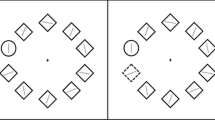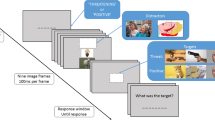Abstract
Anxiety has consistently been found to potentiate attentional capture by physically salient stimuli, which could be due to enhanced distractor processing, impaired goal-directed attention, or both. At the same time, a recent study demonstrated that a threat manipulation reduces attentional capture by reward-associated stimuli, suggesting that anxiety does not increase distractibility or, otherwise, interfere with the control of attention generally. Here, we experimentally induced anxiety via threat-of-shock in the adaptive choice visual search task to examine whether the experience of threat influences goal-directed attentional control. Participants chose to search through one of two task-relevant colors on each trial, where searching through the less abundant color would be optimal for maximizing performance. Performance was evaluated with and without the threat of unpredictable electric shock. Under threat, participants were more optimal in their visual search and missed fewer targets. Performance improvements were demonstrated on trials that the optimal target color switched, demonstrating that threat is beneficial in adapting to changing attentional demands. Our findings demonstrate that threat can facilitate the efficiency of goal-directed attentional control and are at odds with an antagonistic relationship between anxiety and the control of attention.



Similar content being viewed by others

Data availability statement
The data sets during and/or analyzed during the current study are available in the Open Science Framework repository (https://doi.org/10.17605/OSF.IO/TEJKF).
References
Anderson, B. A., & Britton, M. K. (2019). On the automaticity of attentional orienting to threatening stimuli. Emotion. https://doi.org/10.1037/emo0000596.
Anderson, B. A., Laurent, P. A., & Yantis, S. (2011). Value-driven attentional capture. Proceedings of the National Academy of Sciences of the United States of America, 108(25), 10367–10371.
Bar-Haim, Y., Lamy, D., Pergamin, L., Bakermans-Kranenburg, M. J., & van Ijzendoorn, M. H. (2007). Threat-related attentional bias in anxious and nonanxious individuals: A meta-analytic study. Psychological Bulletin, 133(1), 1–24.
Brainard, D. H. (1997). The psychophysics toolbox. Spatial Vision, 10(4), 433–436.
Clark, L., Li, R., Wright, C. M., Rome, F., Fairchild, G., Dunn, B. D., et al. (2012). Risk-avoidant decision making increased by threat of electric shock. Psychophysiology, 49(10), 1436–1443.
Cornwell, B. R., Arkin, N., Overstreet, C., Carver, F. W., & Grillon, C. (2012). Distinct contributions of human hippocampal theta to spatial cognition and anxiety. Hippocampus, 22(9), 1848–1859.
Davis, M., Walker, D. L., Miles, L., & Grillon, C. (2010). Phasic vs sustained fear in rats and humans: Role of the extended amygdala in fear vs anxiety. Neuropsychopharmacology, 35, 105–135.
Easterbrook, J. A. (1959). The effect of emotion on cue utilization and the organization of behavior. Psychological Review, 66, 183–201.
Esterman, M., DeGutis, J., Mercado, R., Rosenblatt, A., Vasterling, J. J., Milberg, W., et al. (2013). Stress-related psychological symptoms are associated with increased attentional capture by visually salient distractors. Journal of the International Neuropsychological Society, 19(7), 835–840.
Etkin, A., Prater, K. E., Hoeft, F., Menon, V., & Schatzberg, A. F. (2010). Failure of anterior cingulate activation and connectivity with the amygdala during implicit regulation of emotional processing in generalized anxiety disorder. American Journal of Psychiatry., 167, 545–554.
Etkin, A., & Schatzberg, A. (2012). Common abnormalities and disorder-specific compensation during implicit regulation of emotional processing in generalized anxiety and major depressive disorders. American Journal of Psychiatry, 168, 968–978.
Eysenck, M. W., Derakshan, N., Santos, R., & Calvo, M. G. (2007). Anxiety and cognitive performance: Attentional control theory. Emotion, 7, 336–353.
Ferreira, R., & Murray, J. (1983). Spielberger state-trait anxiety inventory—measuring anxiety with and without an audience during performance on a stabilometer. Perceptual and Motor Skills, 57(1), 15–18.
Gillan, C.M., Vaghi, M.M., Hezemans, F.H., van Ghesel, G.S., Dafflon, J., Bruhl, A. B., Savulich, G., & Robbins, T. W. (2020). Psychol Med https://doi.org/10.1017/S0033291720000203
Grillon, C. (2008). Models and mechanisms of anxiety: evidence from startle studies. Psychopharmacology (Berlin), 199, 421–437.
Grillon, C., & Charney, D. R. (2011). In the face of fear: Anxiety sensitizes defensize responses to fearful faces. Psychophysiology, 48(12), 1745–1752.
Hu, K., Bauer, A., Padmala, S., & Pessoa, L. (2012). Threat of bodily harm has opposing effects on cognition. Emotion, 12(1), 28–32.
Hu, K., Fan, Z., & He, S. (2015). Uncovering the interaction between emphatic pain and cognition. Psychological Research Psychologische Forschung, 79(6), 1054–1063.
Irons, J. L., & Leber, A. B. (2016). Choosing attentional control settings in a dynamically changing environment. Attention Perception Psychophysics, 78(7), 2031–2048.
Irons, J. L., & Leber, A. B. (2018). Characterizing individual variation in the strategic use of attentional control. Journal of Experimental Psychology: Human Perception and Performance, 44(10), 1637–1654.
Jiang, Y. V., Swallow, K. M., Rosenbaum, G. M., & Herzig, C. (2013). Rapid acquisition but slow extinction of an attentional bias in space. Journal of Experimental Psychology: Human Perception and Performance, 39(1), 87–99.
Kim, A. J., & Anderson, B. A. (2019). Threat reduces value-driven but not salience-driven attentional capture. Emotion. https://doi.org/10.1037/emo0000599.
Krug, M. K., & Carter, C. S. (2012). Proactive and reactive control during emotional interference and its relationship to trait anxiety. Brain Research, 1481, 13–36.
Lee, T. H., Itti, L., & Mather, M. (2012). Evidence for arousal-biased competition in perceptual learning. Front Psychol, 3, 241.
Lee, T. H., Sakaki, M., Cheng, R., Velasco, R., & Mather, M. (2014). Emotional arousal amplifies the effects of biased competition in the brain. Social Cognitive and Affective Neuroscience, 9(12), 2067–2077.
Lindstrom, B. R., & Bohlin, G. (2012). Threat-relevance impairs executive functions: Negative impact on working memory and response inhibition. Emotion, 12(2), 384–393.
Mather, M., & Sutherland, M. R. (2011). Arousal-biased competition in perception and memory. Perspectives on Psychological Science, 6(2), 114–133.
Miu, A. C., Heilman, R. M., & Houser, D. (2008). Anxiety impairs decision-making: Psychophysiological evidence from an Iowa Gambling Task. Biological Psychology, 77(3), 353–358.
Moser, J. S., Becker, M. W., & Moran, T. P. (2012). Enhanced attentional capture in trait anxiety. Emotion, 12(2), 213–216.
Pessoa, L. (2009). How do emotion and motivation direct executive control? Trends in Cognitive Sciences, 13(4), 160–166.
Robinson, O. J., Letkiewicz, A. M., Overstreet, C., Ernst, M., & Grillon, C. (2011). The effect of induced anxiety on cognition: threat of shock enhances aversive processing in healthy individuals. Cognitive Affective Behavioral Neuroscience, 11, 217–227.
Robinson, O. J., Vytal, K., Cornwell, B. R., & Grillon, C. (2013). The impact of anxiety upon cognition: perspectives from human threat of shock studies. Frontiers in Human Neuroscience, 7, 203.
Schmitz, A., & Grillon, C. (2012). Assessing fear and anxiety in humans using the threat of predictable and unpredictable aversive events (the NPU-threat test). Nature Protocols, 7(3), 527–532.
Sutherland, M. R., & Mather, M. (2012). Negative arousal amplifies the effects of saliency in short-term memory. Emotion, 12(6), 1367–1372.
Sutherland, M. R., & Mather, M. (2015). Negative arousal increases the effects of stimulus salience in older adults. Experimental Aging Research, 41(3), 259–271.
Theeuwes, J. (1992). Perceptual selectivity for color and form. Perception & Psychophysics, 51(6), 599–606.
Vuilleumier, P. (2005). How brains beware: Neural mechanisms of emotional attention. Trends in Cognitive Sciences, 9(12), 585–594.
Vytal, K. E., Cornwell, B. R., Letkiewicz, A. M., Arkin, N. E., & Grillon, C. (2013). The complex interaction between anxiety and cognition: Insight from spatial and verbal working memory. Frontiers in Human Neuroscience, 7, 93.
Wolfe, J. M., Cave, K. R., & Franzel, S. L. (1989). Guided search: An alternative to the feature integration model for visual search. Journal of Experimental Psychology: Human Perception and Performance, 15(3), 419–433.
Yang, Y., Miskovich, T. A., & Larson, C. L. (2018). State anxiety impairs proactive but enhances reactive control. Frontiers in Psychology, 9, 2570.
Yerkes, R. M., & Dodson, J. D. (1908). The relation of strength of stimulus to rapidity of habit-formation. Journal of Comparative Neurology and Psychology, 18(5), 459–482.
Acknowledgements
This study was supported by grants from the Brain & Behavior Research Foundation [NARSAD 26008] and National Institutes of Health [R01-DA046410] to BAA.
Funding
This study was supported by Grants from the Brain & Behavior Research Foundation [NARSAD 26008] and National Institutes of Health [R01-DA046410] to BAA.
Author information
Authors and Affiliations
Corresponding author
Ethics declarations
Conflict of interest
The authors declare no conflict of interest.
Ethical approval
All procedures were conducted in accordance with the ethical standards of the Texas A&M University Institutional Review Board and with the 1964 Helsinki declaration and its later amendments.
Informed consent
Informed consent was obtained from all individual participants included in the study.
Additional information
Publisher's Note
Springer Nature remains neutral with regard to jurisdictional claims in published maps and institutional affiliations.
Rights and permissions
About this article
Cite this article
Kim, A.J., Lee, D.S. & Anderson, B.A. The influence of threat on the efficiency of goal-directed attentional control. Psychological Research 85, 980–986 (2021). https://doi.org/10.1007/s00426-020-01321-4
Received:
Accepted:
Published:
Issue Date:
DOI: https://doi.org/10.1007/s00426-020-01321-4



